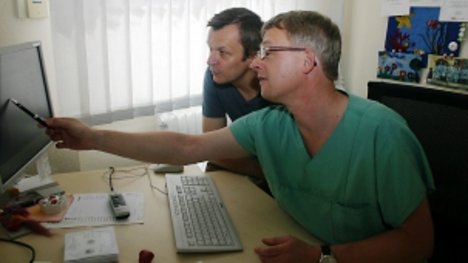"We want to discover time bombs". Magdeburg scientists develop sensors for analysing vascular deposits

"The plaque breaks down, leading to a sudden closure of the vessel", Prof Dr Rüdiger Braun-Dullaeus vividly describes how a stroke or acute heart attack can come about. The cardiologist at the University Hospital Magdeburg understands atherosclerosis, a multi-factorial disease of the artery system, as a disease predominantly in elderly patients and as the most common cause of cardiovascular diseases.
Braun-Dullaeus has been head of cardiology, angiology and pneumology at the university hospital for six years, and has made a name for himself within his scientific field, which is closely connected with systemic cardiovascular diseases. "Saxony-Anhalt takes a leading role in terms of demographic development. With an aging population, cardiovascular diseases will increase", says Braun-Dullaeus. However, according to the physician, research on plaque can positively influence the course of the disease and forms of therapy.
This is because deposits differ from one another in their material composition. Braun-Dullaeus: "There are types of plaque that remain stable. Even a narrowed vessel with up to 90 percent of vascular deposits can be harmless. But there is no reliable method of analysing the composition of the plaque prior to treatment."
The physician has arranged to meet the medical engineer Prof. Dr Georg Rose - both want to formulate the joint research proposal. As always, time is pressing. Rose is the head of the Institute of Medical Technology at the Otto-von-Guericke University Magdeburg. He is an expert in his scientific field of modern medical imaging.
Interdisciplinary research and development in the field of life sciences works out well - Braun-Dullaeus and Rose have already successfully worked on quite a few projects together.
Their latest innovative idea recently received the green light for its application from the German Research Foundation (DFG). As part of the national research programme Electromagnetic Sensors for Life Sciences (ESSENCE), physicians, biologists, and electrical and medical technicians at the Otto-von-Guericke University Magdeburg will develop sensors for analysing vascular deposits over the next six years. The universities in Darmstadt, Frankfurt am Main and Würzburg are also involved in the large research project. The two scientists in Magdeburg, whose research is mostly oriented on a short time period, see the opportunity in this longer period of time to conduct basic research and achieve great effects with far-reaching impacts in the end.
Following the target of ESSENCE, the new sensors should determine the frequency range from gigahertz to terahertz waves in protein and nucleric acid interactions in the field of molecular biology and analyse the disposition of molecules in the field of biochemistry. In medicine, the sensors are to be used in the localisation and treatment of tumours. And they should, such as in the Magdeburg research focus, examine deposits on vascular walls and characterise their properties. The DFG has approved a total of six million euros for the ESSENCE programme.
Georg Rose, who is very familiar with medical issues, considers himself a "translator" in this research project. "In the ESSENCE research network, we have partners such as physicists and electrical engineers", says Rose, "who have not yet researched in the field of medicine." The practicing cardiologist Braun-Dullaeus, however, must explain to the patients in an easily understandable way how their vascular walls pathologically alter because fats have been stored there. "The white blood cells define the fat as a foreign body and want to repair these points by trying to break down the fat. As a result, inflammations develop with calcifications."
The thickness and shape of the deposits, according to Rose, can be detected using modern ultrasound diagnostics. "The electromagnetic sensors should analyse the composition in order to discover the dangerous plaques - the time bombs."
Firstly, the scientists will develop sensors that are still too large to be inserted into the human vascular system. "Their functionality will be tested on medical models and continuously perfected. The final research phase is concerned with the miniaturisation of the chips", the medical engineer explains. The so-called "noses" will be put on a strand on the tip of the catheter in order to guide them through the vessels. The sensors deliver the information in the form of figures, graphs or images. Braun-Dullaeus defines the medical goal of the Magdeburg research focus: "If we appropriately analyse the characteristics and harmfulness of a systematic vascular disease, we can use better and targeted forms of treatment and even be able to develop new treatments."
Author: Kathrain Graubaum
Contacts:
Prof. Dr. Rüdiger C. Braun-Dullaeus
Otto-von-Guericke-Universität Magdeburg
Klinik für Kardiologie, Angiologie und Pneumologie
Tel. 0391/6713203
r.braun-dullaeus.ignore@med.ovgu.de
Prof. Dr. Georg Rose
Otto-von-Guericke-Universität Magdeburg
Institut für Medizintechnik
Tel. 0391/6718862
georg.rose.ignore@ovgu.de
Caption: The cardiologist Rüdiger Braun-Dullaeus (right) and the medical engineer Georg Rose from the Otto-von-Guericke University Magdeburg develop sensors for analysing vascular deposits as part of the DFG research programme ESSENCE
